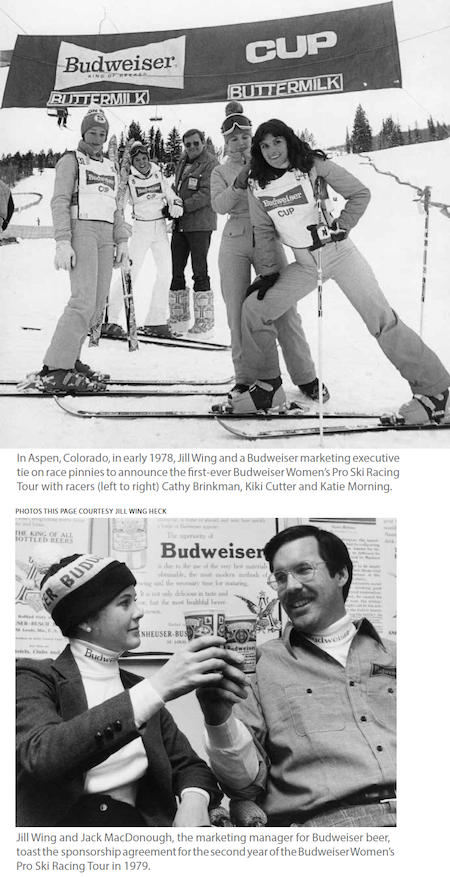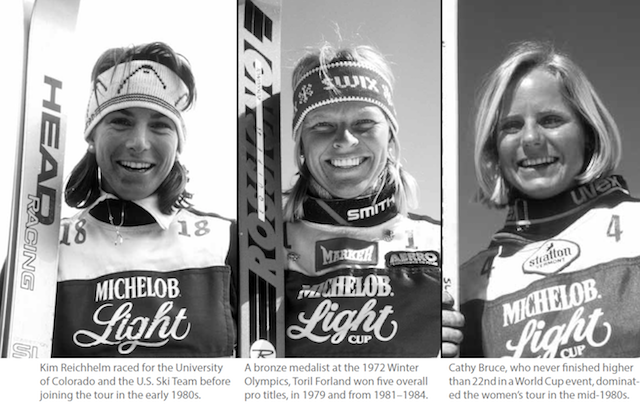
A former competitor remembers the Women’s Pro Ski Tour.
I slid into the starting gate, defined by a low board in the snow four feet behind two “horse gates.” Though I exuded confidence, adrenaline surged through my body. Before me, 25 red panels zigzagged down the slope, next to an identical row of blue panels. The two courses spilled over two six-foot kickers en route to the banner-bedecked finish arena. The racer to my left, Kim Reichhelm, planted her poles and pushed back, lifting her ski tips a foot off the snow as she tested the kick board behind her. Satisfied, she coiled like a puma about to pounce.
slid into the starting gate, defined by a low board in the snow four feet behind two “horse gates.” Though I exuded confidence, adrenaline surged through my body. Before me, 25 red panels zigzagged down the slope, next to an identical row of blue panels. The two courses spilled over two six-foot kickers en route to the banner-bedecked finish arena. The racer to my left, Kim Reichhelm, planted her poles and pushed back, lifting her ski tips a foot off the snow as she tested the kick board behind her. Satisfied, she coiled like a puma about to pounce.
Kim and I had been good friends and fellow competitors since our days as high-school students at Stratton Mountain School in Vermont, but at that moment, we dueled for our paycheck. My eyes fixed on the gates while my ears tuned out all but the starter’s familiar husky voice.
“Red course ready?” he shouted. “Blue course ready? Courses clear. Racers ready…” As the ear-splitting horn pierced the air, the gates sprang open. Kim and I rocketed down the hill, matching each other turn for turn. We thrust ourselves across the finish line and glanced at the clock. After two runs, one on the red course and one on the blue, Kim had bested me by 0.003 second, less than the length of a ski tip.
During my six winters on the Women’s Pro Ski Tour, starting in the mid-1980s, sometimes I was on the winning side of those split seconds and sometimes not. It was challenging, exciting and nerve-racking, not to mention one of the few ways a woman could earn a living as a professional athlete.
“Women’s pro ski racing

was the third-richest pro sport for women at the time,” says Jill Wing Heck, who founded the Women’s Pro Ski Tour in 1978. “It ranked after tennis and golf, but ahead of bowling and rodeo barrel racing.”
While selling sponsorships for the co-ed pro freestyle tour, Wing Heck had befriended Judy Nagel, Susie Corrock and a number of top female alpine ski racers who had switched to freestyle. “There was nothing else,” says Wing Heck. “They talked about how much more fun it would be to race. Then the freestyle tour started having insurance problems, lawsuits due to injuries. Its sponsors fled. No one wanted women’s pro ski racing, so I wrote up a proposal. Anheuser Busch bought it! Then I thought, now what do I do?”
Tony Furman, a New York publicist who was involved with the ski industry, gave Wing Heck office space and offered to do P.R. for the fledging tour. She hired a tournament director, Eric Hvoslef, and put together three events (comprising six races) at Waterville Valley in New Hampshire, Alpine Meadows in California and Vail in Colorado, with a $40,000 purse for the inaugural season. Though Norwegian Toril Forland won the most prize money and three of the four races she entered, Lyndall Heyer of Stowe, Vermont, who entered all six races, accumulated more points and was named the first overall champion.
Over the two decades the tour existed, though many female World Cup standouts competed periodically after retiring from their national teams, most of the stars on the start list were middle-of-the-pack World Cuppers, collegiate All-Americans and Europa Cuppers who never made an Olympic team due to lack of ability or mental toughness, politics or injury. The Women’s Pro Tour gave these athletes a second chance to be world-class, particularly those who thrived on the dual format and the lack of team structure. They tuned their own skis, coordinated their travel and training, and drank adult beverages whether they liked them or not, as Budweiser, Michelob and DeKuyper sponsored the tour at various times. The three overall champions of the women’s pro tour during my era—American Cathy Bruce, Austrian Rowitha Raudaschl and Swede Catarina Glasser-Bjerner—fit this profile. Norwegian Toril Forland, who retired the year after I joined the tour, did not.
Bruce, who never finished higher than 22nd in a World Cup event, dominated the women’s tour during the mid-1980s. “I had a slight confidence problem after being dropped from the [U.S.] team before the 1980 Winter Olympics,” said Bruce in an interview with Los Angeles Times (March 5, 1987). “It took a while for me to grow up mentally, and ski racing is definitely a mental sport.”
Toril Forland was a master at the mental game. A bronze medalist in alpine combined at the 1972 Winter Olympics, she skied for the University of Utah and then joined the pro tour. She won five overall pro titles—in 1979 and from 1981–84. She had an uncanny ability to dial up her intensity as needed, sneaking by a newcomer in an early round before pouring it on for the finals.
Roswitha Raudaschl, a diminutive brunette from Austria, joined the tour as a teenager. She spoke little English but skied with lots of tenacity. She returned to the Alps many thousands of dollars richer. Ditto for Glasser-Bjerner and a handful of women’s pro tour standouts, though not entirely from prize money.

By the time I joined the women’s pro tour in 1985, prize purses at an event varied from $10,000 to $25,000 split between two races per weekend—usually a giant slalom and slalom—with the top 16 each day earning a check. Though no one revealed exactly what they made each year, a top racer with victory bonuses from her sponsors and a willingness to do photo and film shoots and make public appearances could accumulate anywhere from $40,000 to more than $100,000.

When I retired from the tour in 1990, Wing Heck had sold the tour to North American Pro Ski Corporation, which also owned the men’s tour. ESPN was on board with a two-year agreement to broadcast events. Television brought in more sponsors, prize money and athletes. By 1993, the women’s tour boasted a $325,000 prize purse over nine events, but a couple of years later, the women’s tour began to unravel. It’s not clear whether the television coverage disappeared because sponsorships dried up or vice versa, but a year after the millennium, the women’s pro tour was no more.
A member of the Women’s Pro Ski Tour from 1985 to 1990, Lisa Densmore has written about, photographed and televised ski racing for more than 20 years (www.LisaDensmore.com).

